
Work Shifts and Work Periods must be defined in order to use Time Manager.
Earn Codes must be configured prior to configuring Work Shifts and Work Periods. For more information, refer to the Earn Codes.
An employee’s work schedule is comprised of a Work Shift, a Work Period, and meals and breaks, with specific predetermined Start and End Times. Work Shifts and Work Periods are used together with a company Calendar to determine the employee’s default schedule. The schedule comprises the hours an employee is expected to work or is scheduled for vacation or holiday.
The Work Shifts & Work Periods file room provides a view of all of the Work Shifts and Work Periods available by Facility and Pay Rule in the system. Work Shifts and Work Periods are user-definable and the grid is personalizable through the DELMIA Apriso personalization framework. For details on personalization, refer to the Portal Implementation Guide.

To view the Work
Shift Properties, double-click a Work Shift or select one and click
![]() (Properties).
(Properties).
To add a new Work Shift and Work Period:
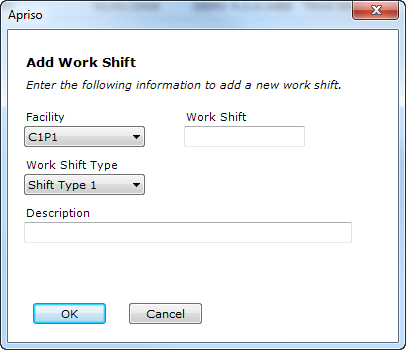
To delete a Work Shift and Work Period, click ![]() (Delete) (you will be asked for confirmation prior to deleting).
(Delete) (you will be asked for confirmation prior to deleting).
The entity will not be removed if it is being referenced elsewhere in the application.
The Work Shift Properties screen enables viewing and modifying the attributes of the entity.
The header of the properties screen contains the following buttons:
The Work Shift Properties
screen is divided into several sections that can be expanded (with  )
and collapsed (with
)
and collapsed (with  ):
):
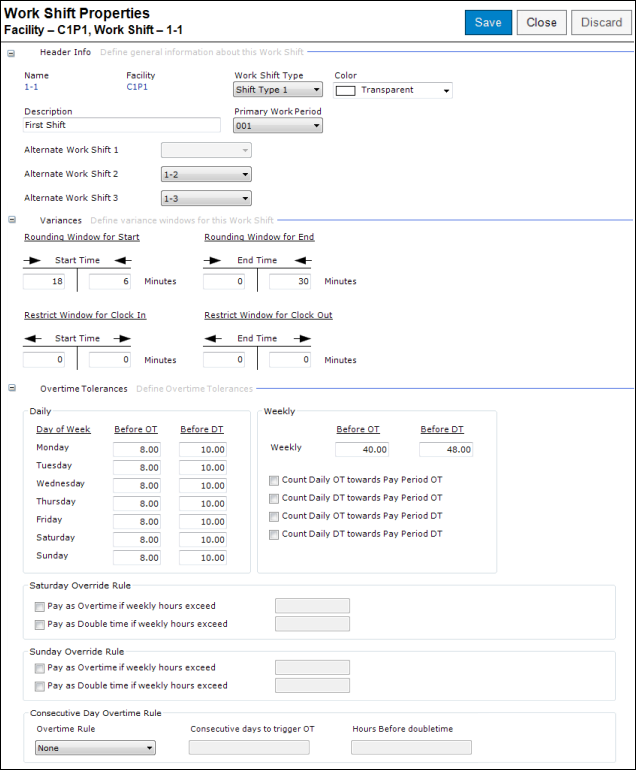
| Attribute | Description |
| Name | The unique identifier of the Work Shift. |
| Facility | The Facility for which this Work Shift is available. |
| Description | The description of the entity. |
| Work Shift Type | Used to define the Shift as a Shift Type 1, 2, or 3. These will be used in coordination with the First, Second, and Third Shift cut-offs for the employees assigned the Pay Rule. |
| Color | A color can be assigned to each different Work Shift Type. The selected color will be displayed on the calendar if a Work Shift is applied. |
| Primary Work Period | The primary Work Period associated with this shift. This is used as the default Work Period when an employee is working on a shift other than that for which they are scheduled. |
| Alternate Shift 1 | This Alternate Shift is used when a Clock In for a shift falls after a shift cut-off such that a new computed shift is assigned to the worker other than their home shift assignment. It is deactivated if this shift is a Shift Type 1. |
| Alternate Shift 2 | This Alternate Shift is used when a Clock In for a shift falls after a shift cut-off such that a new computed shift is assigned to the worker other than their home shift assignment. It is deactivated if this shift is a Shift Type 2. |
| Alternate Shift 3 | This Alternate Shift is used when a Clock In for a shift falls after a shift cut-off such that a new computed shift is assigned to the worker other than their home shift assignment. It is deactivated if this shift is a Shift Type 3. |
| Attribute | Description |
| Rounding Start Time Min > | The window on the early side of the scheduled Start Time for
this shift, within which a Clock In will round to the scheduled
Start Time. For this example, assume a scheduled Start Time of
7:00 with a 15-minute early Rounding Start Time.
|
| Rounding Start Time Min < | The variance window on the late side of the scheduled Start
Time for this shift, within which a Clock In will round to the
scheduled Start Time. For this example, assume a scheduled Start
Time of 7:00 with a 6-minute late Rounding Start Time.
|
| Rounding End Time Min > | The variance window on the early side of the scheduled End
Time for this shift, within which a Clock Out will round to the
scheduled End Time. For this example, assume a scheduled End Time
of 15:30 with a 3-minute early Rounding End Time.
|
| Rounding End Time Min < | The variance window on the late side of the scheduled End Time
for this shift, within which a Clock Out will round to the scheduled
End Time. For this example, assume a scheduled End Time of 15:30
with a 20-minute late Rounding End Time.
|
| Restrict Start Time Min < | The restriction window on the early side of the scheduled Start
Time for this shift. A Clock In outside of this restriction window
will be rejected. For this example, assume a scheduled Start Time
of 7:00 with a 45-minute early restriction window.
|
| Restrict Start Time Min > | The restriction window on the late side of the scheduled Start
Time for this shift. A Clock In outside of this restriction
window will be rejected. For this example, assume a scheduled
Start Time of 7:00 with a 45-minute late restriction window.
Restrict Late Start Time Min Work Shift |
| Restrict End Time Min < | The restriction window on the early side of the scheduled End
Time for this shift. A Clock Out outside of this restriction window
will be rejected. For this example, assume a scheduled End Time
of 15:30 with a 45-minute early restriction window.
|
| Restrict End Time Min > | The restriction window on the late side of the scheduled End
Time for this shift. A Clock Out outside of this restriction window
will be rejected. For this example, assume a scheduled End Time
of 15:30 with a 45-minute late restriction window.
|
| Attribute | Description | ||||||||||||||||||||||||||||||||||||||||||||
| Monday Before OT | The minimum daily hours for a Monday before pay moves from the REG to OT on the timesheet. | ||||||||||||||||||||||||||||||||||||||||||||
| Monday Before DT | The minimum daily hours for a Monday before pay moves from the REG or OT to DT on the timesheet. | ||||||||||||||||||||||||||||||||||||||||||||
| Tuesday Before OT | The minimum daily hours for a Tuesday before pay moves from REG to OT on the timesheet. | ||||||||||||||||||||||||||||||||||||||||||||
| Tuesday Before DT | The minimum daily hours for a Tuesday before pay moves from REG or OT to DT on the timesheet. | ||||||||||||||||||||||||||||||||||||||||||||
| Wednesday Before OT | The minimum daily hours for a Wednesday before pay moves from REG to OT on the timesheet. | ||||||||||||||||||||||||||||||||||||||||||||
| Wednesday Before DT | The minimum daily hours for a Wednesday before pay moves from REG or OT to DT on the timesheet. | ||||||||||||||||||||||||||||||||||||||||||||
| Thursday Before OT | The minimum daily hours for a Thursday before pay moves from REG to OT on the timesheet. | ||||||||||||||||||||||||||||||||||||||||||||
| Thursday Before DT | The minimum daily hours for a Thursday before pay moves from REG or OT to DT on the timesheet. | ||||||||||||||||||||||||||||||||||||||||||||
| Friday Before OT | The minimum daily hours for a Friday before pay moves from REG to OT on the timesheet. | ||||||||||||||||||||||||||||||||||||||||||||
| Friday Before DT | The minimum daily hours for a Friday before pay moves from REG or OT to DT on the timesheet. | ||||||||||||||||||||||||||||||||||||||||||||
| Saturday Before OT | The minimum daily hours for a Saturday before pay moves from REG to OT on the timesheet. | ||||||||||||||||||||||||||||||||||||||||||||
| Saturday Before DT | The minimum daily hours for a Saturday before pay moves from REG or OT to DT on the timesheet. | ||||||||||||||||||||||||||||||||||||||||||||
| Sunday Before OT | The minimum daily hours for a Sunday before pay moves from REG to OT on the timesheet. | ||||||||||||||||||||||||||||||||||||||||||||
| Sunday Before DT | The minimum daily hours for a Sunday before pay moves from REG or OT to DT on the timesheet. | ||||||||||||||||||||||||||||||||||||||||||||
| Weekly Before OT | The minimum weekly cumulative hours before pay moves from REG to OT on the timesheet. | ||||||||||||||||||||||||||||||||||||||||||||
| Weekly Before DT | The minimum weekly cumulative hours before pay moves from REG or OT to DT on the timesheet. | ||||||||||||||||||||||||||||||||||||||||||||
| Count Daily OT towards Pay Period OT | Daily OT can count toward weekly OT or be excluded from the
total.
If you pay daily OT for hours in excess of 8.0
and weekly OT for hours in excess of 40.0, you might have the
following scenario: an employee is scheduled to work 7:00 AM to
3:30 PM Monday through Friday. The employee stays late on Monday
until 5:30 PM, so Monday’s hours are allocated as 8.00 REG, and
2.00 OT. The employee works as scheduled for the duration of the
week. On Friday at 1:30 PM, the employee has total hours as follows:
On Friday at 3:30 PM, when this flag is checked, the employee's Friday will look as follows:
On Friday at 3:30 PM, when this flag is not checked, the employee's Friday will look as follows:
|
||||||||||||||||||||||||||||||||||||||||||||
| Count Daily DT towards Pay Period OT |
Daily DT can count toward weekly OT or be excluded from the total. See the explanation for Count Daily OT towards Pay Period OT above. |
||||||||||||||||||||||||||||||||||||||||||||
| Count Daily OT towards Pay Period DT |
Daily OT can count toward weekly DT or be excluded from the total. See the explanation for Count Daily OT towards Pay Period OT above. |
||||||||||||||||||||||||||||||||||||||||||||
| Count Daily DT towards Pay Period DT |
Daily DT can count toward weekly DT or be excluded from the total. See the explanation for Count Daily OT towards Pay Period OT above. |
||||||||||||||||||||||||||||||||||||||||||||
| Saturday Override Rule – Pay as Overtime if weekly hours exceed (hours) | The flag to override the general rule for a more specific Saturday rule. If selected, Saturday will be paid as Overtime if the weekly hours exceed the hours entered. | ||||||||||||||||||||||||||||||||||||||||||||
| Saturday Override Rule – Pay as Double time if weekly hours exceed (hours) | The flag to override the general rule for a more specific Saturday rule. If selected, Saturday will be paid as Double Time if the weekly hours exceed the hours entered. | ||||||||||||||||||||||||||||||||||||||||||||
| Sunday Override Rule – Pay as Overtime if weekly hours exceed (hours) | The flag to override the general rule for a more specific Sunday rule. If selected, Sunday will be paid as Overtime if the weekly hours exceed the hours entered. | ||||||||||||||||||||||||||||||||||||||||||||
| Sunday Override Rule – Pay as Double time if weekly hours exceed (hours) | The flag to override the general rule for a more specific Sunday rule. If selected, Sunday will be paid as Double Time if the weekly hours exceed the hours entered. | ||||||||||||||||||||||||||||||||||||||||||||
| Consecutive Day Overtime Rule – Overtime Rule | This rule determines that an employee's attendance should be
counted as Overtime if the employee has worked a certain number
of days in a row (even if the total hours for the specific day
and the hours-to-date for the week do not trigger Overtime rules).
The possible values are:
|
||||||||||||||||||||||||||||||||||||||||||||
| Consecutive Day Overtime Rule – Consecutive days to trigger OT | The number of consecutive days after which the Consecutive Day Overtime Rule is triggered. | ||||||||||||||||||||||||||||||||||||||||||||
| Consecutive Day Overtime Rule – Hours Before doubletime | The number of hours before Double Time is applied to the days that fall under the Consecutive Day Overtime Rule. |

To see the Work Shift Break Properties,
double-click a Work Shift Break or select one and click ![]() (Properties).
(Properties).
To add a new Work Shift Break:
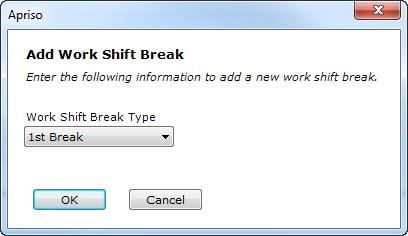
To delete a Work Shift Break, select ![]() (Delete) (you will be asked for confirmation prior to deleting).
(Delete) (you will be asked for confirmation prior to deleting).
The entity will not be removed if it is being referenced elsewhere in the application.
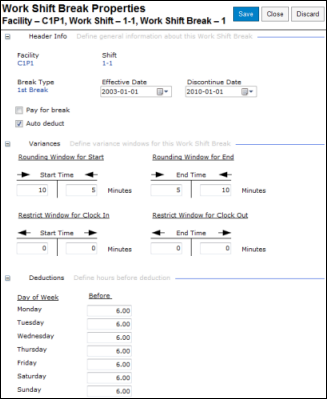
You can define the following information for the Work Shift Break:
| Attribute | Description |
| Facility | The Facility for which this Work Shift Break is available. |
| Shift | The Work Shift for which this Work Shift Break is available. |
| Break Type | The available types are as follows:
|
| Effective Date | The date from which the break is applicable. |
| Discontinue Date | The date at which the break stops being applicable. |
| Pay for Break | Used to determine if breaks count towards paid hours. Breaks that are not set to Pay for Break will deduct the hours from the open attendance and open labor. This is typically used to track lunch. |
| Auto Deduct | Determines if a break is automatically deducted from attendance and labor or if the employee is required to perform a Start Break and Stop Break. A Work Shift Break will not be created if the Payday is outside of the Effective Date and Discontinue Date (see above). |
| Rounding Start Time Min > | The variance window on the early side of the scheduled Start
Break, within which a Start Break will round to the scheduled
Start Break Time. For this example, assume a scheduled Break Start
Time of 11:00 with a 6-minute early Break Rounding Start Time.
|
| Rounding Start Time Min < | The variance window on the late side of the scheduled Start
Break, within which a Start Break will round to the scheduled
Start Break Time. For this example, assume a scheduled Break Start
Time of 11:00 with a 6-minute late Break Rounding Start Time.
|
| Rounding End Time Min > | The variance window on the early side of the scheduled End
Break, within which a Stop Break will round to the scheduled End
Break Time. For this example, assume a scheduled Break End Time
of 11:30 with a 6-minute early Break Rounding End Time.
|
| Rounding End Time Min < | The variance window on the late side of the scheduled End Break,
within which a Stop Break will round to the scheduled End Break
Time. For this example, assume a scheduled Break End Time of 11:30
with a 6-minute late Break Rounding End Time.
|
| Restrict Start Time Min < | The restriction window on the early side of the scheduled Break
Start. A Start Break outside this restriction window will be rejected.
For the following example, assume a scheduled Start Time of 11:00
with a 15-minute early restriction window.
|
| Restrict Start Time Min > | The restriction window on the late side of the scheduled Break
Start. A Start Break outside this restriction window will be rejected.
For the following example, assume a scheduled Start Time of 11:00
with a 15-minute late restriction window.
|
| Restrict End Time Min < | The restriction window on the early side of the scheduled Break
End. A Stop Break outside this restriction window will be rejected.
For the following example, assume a scheduled End Time of 11:30
with a 15-minute early restriction window.
|
| Restrict End Time Min > | The restriction window on the late side of the scheduled Break
End Time. A Stop Break outside this restriction window will be
rejected. For the following example, assume a scheduled End Time
of 11:30 with a 15-minute late restriction window.
|
| Monday before Deduction | The amount of worked hours an employee must have accumulated prior to the automatic deduction of a break for Monday. |
| Tuesday before Deduction | The amount of worked hours an employee must have accumulated prior to the automatic deduction of a break for Tuesday. |
| Wednesday before Deduction | The amount of worked hours an employee must have accumulated prior to the automatic deduction of a break for Wednesday. |
| Thursday before Deduction | The amount of worked hours an employee must have accumulated prior to the automatic deduction of a break for Thursday. |
| Friday before Deduction | The amount of worked hours an employee must have accumulated prior to the automatic deduction of a break for Friday. |
| Saturday before Deduction | The amount of worked hours an employee must have accumulated prior to the automatic deduction of a break for Saturday. |
| Sunday before Deduction | The amount of worked hours an employee must have accumulated prior to the automatic deduction of a break for Sunday. |

To see the Work Period Properties,
double-click a Work Period or select one and click ![]() (Properties).
(Properties).
To add a new Work Period:
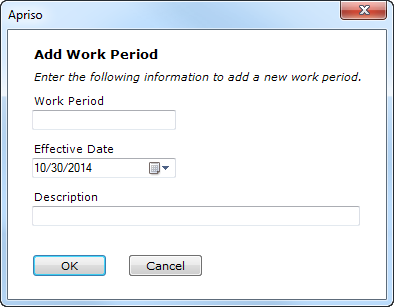
To delete a Work Period, click ![]() (Delete)
(you will be asked for confirmation prior to deleting).
(Delete)
(you will be asked for confirmation prior to deleting).
The entity will not be removed if it is being referenced elsewhere in the application.
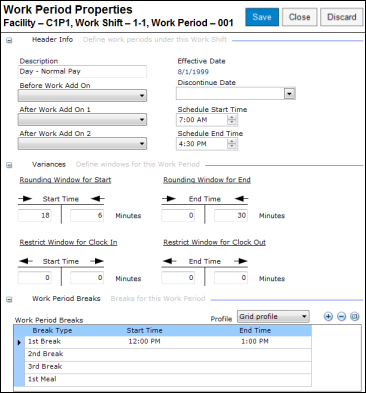
You can define the following information for the Work Period:
| Attribute | Description |
| Description | The description of the Work Period |
| Before Work Add On | An attribute that is carried to the attendance record indicating a Work Add On before Overtime. An example would be to add $1 per Regular hour to the pay (calculated external to Time Manager). |
| After Work Add On 1 | An attribute that gets carried to the attendance record indicating a Work Add On after Overtime. An example would be to add $2 per Overtime hour to the pay (calculated external to Time Manager). |
| After Work Add On 2 | An attribute that gets carried down to the attendance record indicating a Work Add On after Overtime. An example would be to add $2 per Overtime hour to pay (calculated external to Time Manager). |
| Discontinue Date | The date from which the Work Period becomes unavailable. |
| Schedule Start Time | The scheduled start time for this Work Period. |
| Schedule End Time | The scheduled end time for this Work Period, which is usually the Schedule Start Time plus the duration of scheduled work and the duration of a paid break for the day. For example, assume an 8.0-hour payday starting at 7:00, with a 30-minute lunch break at 11:00. The Schedule Start Time would be 7:00 AM, and the Schedule End Time would be 3:30 PM. |
| Rounding Start Time Min > | The variance window on the early side of the Schedule
Start Time for this period, within which a Clock In will
round to the Schedule Start Time.
|
| Rounding Start Time Min < | The variance window on the late side of the Schedule
Start Time for this period, within which a Clock In will
round to the Schedule Start Time.
|
| Rounding End Time Min > | The variance window on the early side of the Schedule
End Time for this period, within which a Clock Out will
round to the Schedule End Time.
|
| Rounding End Time Min < | The variance window on the late side of the Schedule
End Time for this period, within which a Clock Out will
round to the Schedule End Time.
|
| Restrict Start Time Min < | The restriction window on the early side of the Schedule
Start Time for this Work Period. A Clock In outside this
restriction window will be rejected. For this example, assume
a Schedule Start Time of 7:00 with
a 45-minute early restriction window.
|
| Restrict Start Time Min > | The restriction window on the late side of the Schedule
Start Time for this Work Period. A Clock In outside this
restriction window will be rejected. For the following example,
assume a Schedule Start Time of 7:00
with a 45-minute late restriction window.
|
| Restrict End Time Min < | The restriction window on the early side of the Schedule
End Time for this Work Period. A Clock Out outside this
restriction window will be rejected. For the following example,
assume a Schedule End Time of 15:30
with a 45-minute early restriction window.
|
| Restrict End Time Min > | The restriction window on the late side of the Schedule
End Time for this Work Period. A Clock Out outside this
restriction window will be rejected. For the following example,
assume a Schedule End Time of 15:30
with a 45-minute late restriction window.
|

To add a new Work Period Break:
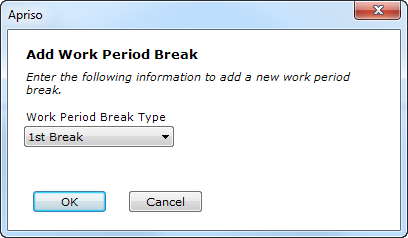
To delete a Work Period Break, select ![]() (Delete)
(you will be asked for confirmation prior to deleting).
(Delete)
(you will be asked for confirmation prior to deleting).
The entity will not be removed if it is being referenced elsewhere in the application.
To see the Work
Period Break Properties screen, double-click a Work Period
Break or select one and click ![]() (Properties).
(Properties).
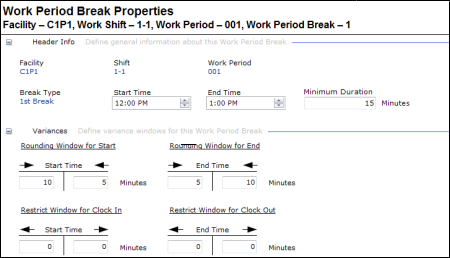
You can define the following information for the Work Period Break:
| Attribute | Description |
| Facility | The Facility for which this Work Period Break is available. |
| Shift | The shift for which this Work Period Break is available. |
| Work Period | The Work Period for which this Work Period Break is available. |
| Break Type | The available types are as follows:
|
| Start Time | The start time for the Work Period Break. |
| End Time | The end time for the Work Period Break. The End Time cannot be earlier than the Start Time. |
| Minimum Duration |
The minimum required duration for the Work Period Break (e.g., 15 minutes). The attribute is effective for approval and sign off as an exception. This attribute does not limit the recess related Business Components nor creating or modifying breaks in the Time Manager. |
| Rounding Start Time Min > | The variance window on the early side of the Schedule Start
Break Time, within which a Start Break will round to the Schedule
Start Break Time. For the following example, assume a Schedule
Break Start Time of 11:00 with a 6-minute early Break Rounding
Start Time.
|
| Rounding Start Time Min < | The variance window on the late side of the Schedule Start
Break, within which a Start Break will round to the Schedule Start
Break Time. For the following example, assume a Schedule Break
Start Time of 11:00 with a 6-minute late Break Rounding Start
Time.
|
| Rounding End Time Min > | The variance window on the early side of the Schedule End Break
Time, within which a Stop Break will round to the Schedule End
Break Time. For the following example, assume a Scheduled Break
End Time of 11:30 with a 6-minute early Break Rounding End Time.
|
| Rounding End Time Min < | The variance window on the late side of the Schedule End Break
Time, within which a Stop Break will round to the Schedule End
Break Time. For the following example, assume a Schedule Break
End Time of 11:30 with a 6-minute late Break Rounding End Time.
|
| Restrict Start Time Min < | The restriction window on the early side of the Schedule Break
Start Time. A Start Break outside this restriction window will
be rejected. For the following example, assume a Scheduled Start
Time of 11:00 with a 15-minute early restriction window.
|
| Restrict Start Time Min > | The restriction window on the late side of the Schedule Break
Start Time. A Start Break outside this restriction window will
be rejected. For the following example, assume a Schedule Start
Time of 11:00 with a 15-minute late restriction window.
|
| Restrict End Time Min < | The restriction window on the early side of the Schedule Break
End Time. A Stop Break outside this restriction window will be
rejected. For the following example, assume a Schedule End Time
of 11:30 with a 15-minute early restriction window.
|
| Restrict End Time Min > | The restriction window on the late side of the Schedule Break
End Time. A Stop Break outside this restriction window will be
rejected. For the following example, assume a Schedule End Time
of 11:30 with a 15-minute late restriction window.
|